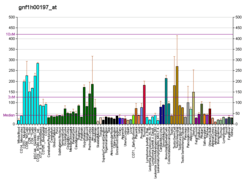ZDHHC9
Palmitoyltransferase ZDHHC9 is an enzyme that in humans is encoded by the ZDHHC9 gene that contains a DHHC domain.[5][6]
References
- 1 2 3 GRCh38: Ensembl release 89: ENSG00000188706 - Ensembl, May 2017
- 1 2 3 GRCm38: Ensembl release 89: ENSMUSG00000036985 - Ensembl, May 2017
- ↑ "Human PubMed Reference:".
- ↑ "Mouse PubMed Reference:".
- ↑ Lai CH, Chou CY, Ch'ang LY, Liu CS, Lin W (Aug 2000). "Identification of Novel Human Genes Evolutionarily Conserved in Caenorhabditis elegans by Comparative Proteomics". Genome Res. 10 (5): 703–13. doi:10.1101/gr.10.5.703. PMC 310876. PMID 10810093.
- ↑ "Entrez Gene: ZDHHC9 zinc finger, DHHC-type containing 9".
Further reading
- Strausberg RL, Feingold EA, Grouse LH, et al. (2003). "Generation and initial analysis of more than 15,000 full-length human and mouse cDNA sequences". Proc. Natl. Acad. Sci. U.S.A. 99 (26): 16899–903. doi:10.1073/pnas.242603899. PMC 139241. PMID 12477932.
- Clark HF, Gurney AL, Abaya E, et al. (2003). "The Secreted Protein Discovery Initiative (SPDI), a Large-Scale Effort to Identify Novel Human Secreted and Transmembrane Proteins: A Bioinformatics Assessment". Genome Res. 13 (10): 2265–70. doi:10.1101/gr.1293003. PMC 403697. PMID 12975309.
- Ota T, Suzuki Y, Nishikawa T, et al. (2004). "Complete sequencing and characterization of 21,243 full-length human cDNAs". Nat. Genet. 36 (1): 40–5. doi:10.1038/ng1285. PMID 14702039.
- Fu GK, Wang JT, Yang J, et al. (2005). "Circular rapid amplification of cDNA ends for high-throughput extension cloning of partial genes". Genomics. 84 (1): 205–10. doi:10.1016/j.ygeno.2004.01.011. PMID 15203218.
- Gerhard DS, Wagner L, Feingold EA, et al. (2004). "The Status, Quality, and Expansion of the NIH Full-Length cDNA Project: The Mammalian Gene Collection (MGC)". Genome Res. 14 (10B): 2121–7. doi:10.1101/gr.2596504. PMC 528928. PMID 15489334.
- Ross MT, Grafham DV, Coffey AJ, et al. (2005). "The DNA sequence of the human X chromosome". Nature. 434 (7031): 325–37. doi:10.1038/nature03440. PMC 2665286. PMID 15772651.
- Swarthout JT, Lobo S, Farh L, et al. (2005). "DHHC9 and GCP16 constitute a human protein fatty acyltransferase with specificity for H- and N-Ras". J. Biol. Chem. 280 (35): 31141–8. doi:10.1074/jbc.M504113200. PMID 16000296.
- Raymond FL, Tarpey PS, Edkins S, et al. (2007). "Mutations in ZDHHC9, Which Encodes a Palmitoyltransferase of NRAS and HRAS, Cause X-Linked Mental Retardation Associated with a Marfanoid Habitus". Am. J. Hum. Genet. 80 (5): 982–7. doi:10.1086/513609. PMC 1852737. PMID 17436253.
- Mansilla F, Birkenkamp-Demtroder K, Kruhøffer M, et al. (2007). "Differential expression of DHHC9 in microsatellite stable and instable human colorectal cancer subgroups". Br. J. Cancer. 96 (12): 1896–903. doi:10.1038/sj.bjc.6603818. PMC 2359975. PMID 17519897.
This article is issued from
Wikipedia.
The text is licensed under Creative Commons - Attribution - Sharealike.
Additional terms may apply for the media files.




